Wondering how long those aggressive mud tires will last on your rig? I’ve been there too. After years of off-roading adventures and helping fellow enthusiasts maximize their tire investments, I’ve learned that mud tire lifespan isn’t as straightforward as it might seem.
The truth is, mud tires typically last between 20,000 to 40,000 miles depending on several critical factors. Your driving habits, maintenance routine, and even the specific terrain you tackle can dramatically impact how long you’ll enjoy those impressive treads. While these specialized tires offer unmatched performance in challenging conditions, they come with different longevity expectations than your standard all-seasons.
Understanding Mud Tire Longevity
Mud tire longevity depends on several key factors that directly impact their lifespan. Most mud tires last between 20,000 to 40,000 miles, though I’ve seen some premium brands reach up to 50,000 miles with proper care. The aggressive tread patterns that make mud tires excellent for off-road performance also contribute to their faster wear rate on paved surfaces.
Tread depth plays a crucial role in determining how long mud tires last. New mud tires typically start with 15/32″ to 19/32″ of tread depth, significantly deeper than all-season tires. This extra depth provides the traction needed for muddy conditions but wears down more quickly on highways and paved roads due to the softer rubber compounds used in their construction.
The rubber composition of mud tires creates a trade-off between grip and longevity. Manufacturers use softer rubber compounds to enhance traction in difficult terrain, but these same compounds wear faster than the harder rubber used in highway tires. This is why many serious off-roaders I’ve met use a separate set of tires for daily driving versus weekend adventures.
Temperature variations also affect mud tire durability. In extremely cold weather, mud tire rubber becomes stiffer and may crack prematurely. Conversely, hot conditions can soften the rubber and accelerate wear, especially during aggressive driving. I’ve noticed my mud tires showing signs of faster wear during summer months in southern states compared to more moderate climates.
Average Lifespan of Mud Tires
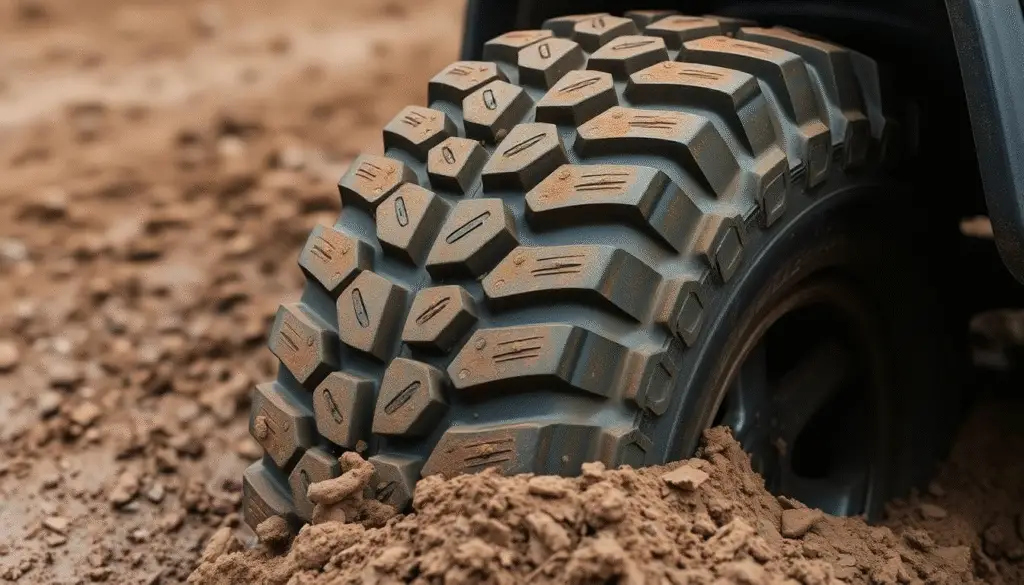
Mud tires typically last between 20,000 to 40,000 miles, though this range varies significantly based on several factors. My experience with various mud tire brands has shown that their lifespan depends heavily on driving conditions, maintenance practices, and the specific brand quality.
Mileage Expectations for Popular Brands
Popular mud tire brands offer different mileage warranties that reflect their expected longevity. BFGoodrich Mud-Terrain T/A KM3 tires generally last 30,000-40,000 miles with proper rotation and maintenance. Goodyear Wrangler MT/R tires often reach similar mileage, while Nitto Trail Grapplers have proven to last up to 40,000 miles in mixed driving conditions. Mickey Thompson Baja MTZ tires typically provide 30,000-35,000 miles before requiring replacement.
Premium brands like Toyo Open Country M/T and Falken Wildpeak M/T often outperform budget options, sometimes reaching 45,000 miles with careful use. I’ve noticed that Cooper Discoverer STT Pro tires tend to last 35,000-40,000 miles when used predominantly on highways with occasional off-road excursions. Budget-friendly options like Thunderer Trac Grip M/T typically offer 20,000-25,000 miles before needing replacement.
Comparing Mud Tires to All-Terrain Options
Mud tires consistently have shorter lifespans than all-terrain alternatives due to their specialized design features. All-terrain tires typically last 40,000-60,000 miles, nearly double the lifespan of mud tires. This significant difference stems from mud tires’ aggressive tread patterns and softer rubber compounds that accelerate wear on paved surfaces.
The deeper lugs on mud tires create more friction and heat during highway driving, causing faster tread deterioration compared to the balanced design of all-terrain options. All-terrain tires feature more densely packed tread blocks and harder rubber compounds specifically engineered for longevity on multiple surfaces.
While mud tires excel in deep mud, rocky terrain, and severe off-road conditions, their performance benefits come with a trade-off in longevity. All-terrain tires offer better on-road comfort, reduced road noise, and improved fuel efficiency alongside their extended lifespan. For drivers who spend 80% or more time on paved roads with only occasional off-road adventures, all-terrain tires typically provide better value despite their reduced capability in extreme conditions.
Factors That Affect Mud Tire Durability
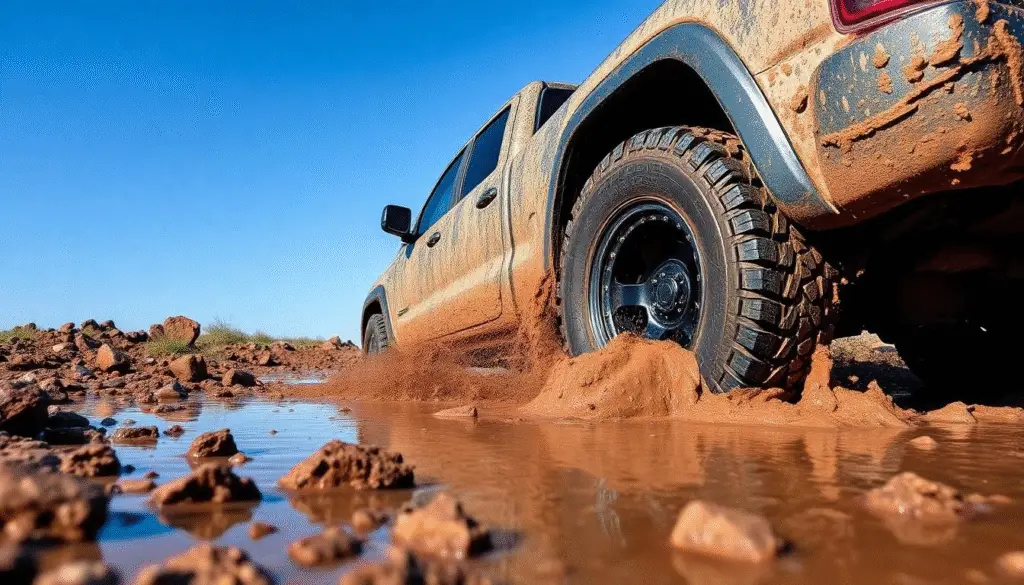
Mud tire longevity varies dramatically based on several critical factors. Through my years of off-roading experience, I’ve observed that identical tire sets can last drastically different amounts of time depending on how and where they’re used. Understanding these key durability factors helps predict how long your mud tires will last and potentially extend their usable life.
Driving Conditions and Terrain Impact
Terrain types directly determine how quickly mud tires wear down. Highway driving accelerates tread wear significantly—the aggressive mud tire lugs flex and scrub against pavement, causing faster deterioration than off-road use. Rocky terrains create cuts and chips in the tread blocks and sidewalls, while sharp obstacles can cause punctures that permanently damage tires. Muddy conditions, ironically, cause less wear on mud tires than pavement, though embedded debris can lead to premature aging.
Temperature extremes also affect longevity. In desert environments where temperatures exceed 100°F, the rubber compound softens excessively, causing faster tread wear during cornering and braking. Conversely, in regions with freezing temperatures, mud tires become stiff and less pliable, potentially developing small cracks that compromise structural integrity over time.
Maintenance Practices
Proper tire maintenance significantly extends mud tire life. Regular pressure checks every 2-3 weeks prevent underinflation, which causes excessive sidewall flexing and heat buildup. Maintaining manufacturer-recommended pressure levels (typically 35-45 PSI for most trucks) optimizes tread wear patterns and prevents premature failure.
Rotation schedules dramatically impact overall tire longevity. Mud tires benefit from rotation every 5,000 miles, which equalizes wear patterns across all four positions. During rotations, thorough inspections allow early detection of uneven wear, cuts, or embedded objects before they cause catastrophic failure.
Wheel alignment directly affects tread life. Misaligned suspension components create irregular wear patterns that can reduce mud tire lifespan by 30-40%. Annual alignment checks, particularly after significant off-road use, preserve even tread wear across the tire surface.
Vehicle Weight and Load
Vehicle weight creates a direct correlation with mud tire durability. Heavier vehicles compress tire treads more significantly against driving surfaces, accelerating wear rates. For example, a 7,000-pound loaded truck wears tires approximately 20-25% faster than a 5,000-pound vehicle with identical driving patterns.
Aftermarket modifications impact tire longevity substantially. Lift kits alter suspension geometry, potentially creating unusual wear patterns if not properly adjusted. Engine performance modifications increase torque delivery, which can accelerate tread wear through increased wheelspin during acceleration.
Load capacity ratings matter significantly when selecting mud tires. Consistently exceeding a tire’s load rating by hauling or towing heavy loads compresses the tire structure beyond design parameters, generating excessive heat and accelerating wear. This overloading effectively reduces potential tire lifespan from 30,000+ miles to potentially less than 20,000 miles in severe cases.
Signs Your Mud Tires Need Replacement
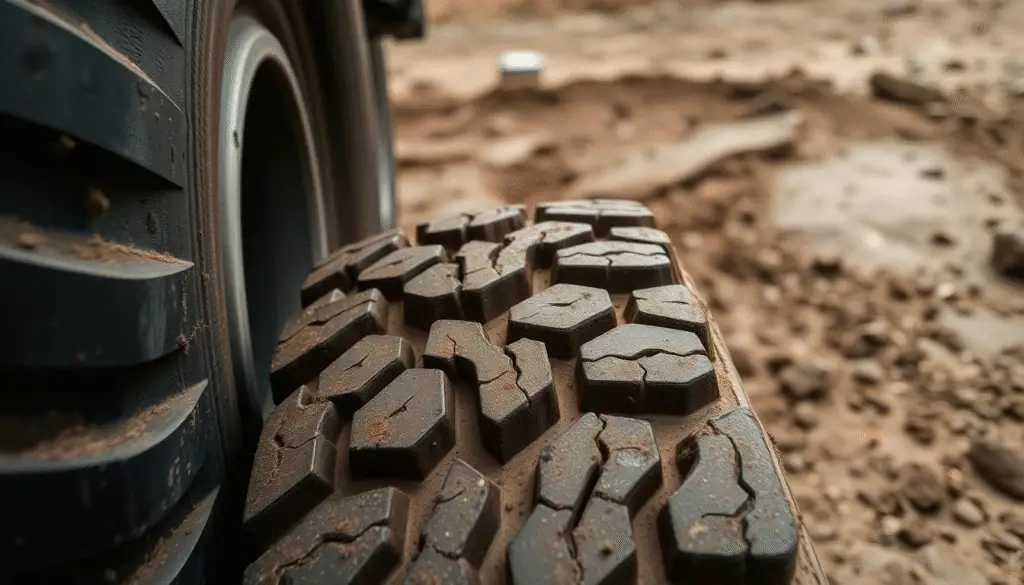
Recognizing when mud tires have reached the end of their useful life is crucial for maintaining safety and performance off-road. Even the most durable mud tires eventually wear out, typically after 20,000-40,000 miles depending on the brand and conditions. Here are the key indicators that it’s time for new rubber.
Tread Wear Indicators
Mud tires feature built-in tread wear indicators that provide clear signals when replacement is necessary. These indicators appear as horizontal bars across the tire’s grooves, becoming increasingly visible as the tread wears down. When these bars are flush with the surrounding tread, your tire has reached the legal minimum tread depth of 2/32 inch.
For off-road driving, however, waiting until the legal minimum isn’t ideal. I’ve learned that mud tires lose significant traction capabilities once tread depth falls below 6/32 inch. At this point, the aggressive lugs that give mud tires their characteristic performance begin to lose their effectiveness in challenging terrain.
The penny test is a quick way to check tread depth at home. Insert a penny into the tread groove with Lincoln’s head upside down—if you can see all of Lincoln’s head, your tires have less than 2/32 inch of tread remaining and need immediate replacement. For mud-specific performance, I use a quarter instead—if Washington’s head is visible, the tread is below 4/32 inch, indicating diminished off-road capability.
Performance Changes to Watch For
Beyond measurable tread wear, noticeable performance changes often signal that mud tires are approaching the end of their lifespan. Reduced traction in muddy conditions is the most obvious indicator—when tires that once powered through thick mud start to spin and struggle, the aggressive edges of the tread blocks have likely worn down too much to be effective.
Increased hydroplaning on wet roads indicates that the tire’s channels can no longer efficiently evacuate water. I’ve experienced this transition myself—mud tires that once felt planted in heavy rain gradually become unpredictable and sketchy as their tread wears down.
Unusual vibrations or roughness while driving may also indicate uneven wear patterns. Mud tires commonly develop cupping or scalloping, especially if rotation schedules haven’t been maintained. This uneven wear not only affects comfort but significantly reduces the remaining lifespan of your tires.
Excessive road noise represents another key performance change. While mud tires are naturally louder than highway tires, a sudden increase in volume often indicates that the tread pattern has worn unevenly. I’ve noticed that as mud tires approach the 30,000-mile mark, the noise level can change dramatically as the tread blocks wear down at different rates.
Difficulty handling in off-camber situations, reduced climbing ability on rocky terrain, or struggling in light mud that previously posed no challenge are all performance-based signs that your mud tires have served their purpose and require replacement, regardless of how many miles they’ve traveled.
Extending the Life of Your Mud Tires
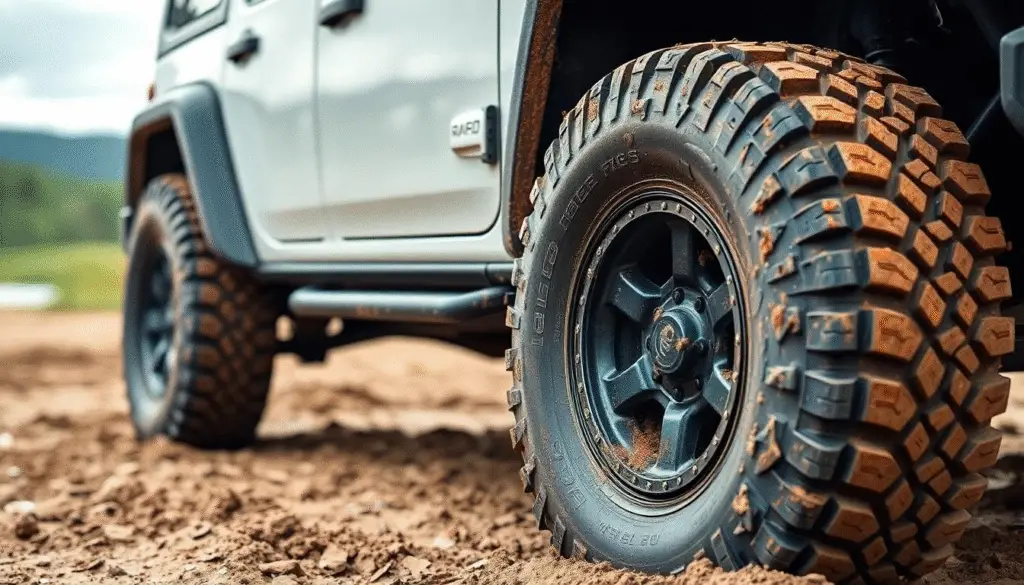
Proper maintenance significantly extends how long mud tires last beyond their typical 20,000-40,000 mile lifespan. I’ve found that with consistent care and attention to a few key areas, you can maximize your investment and keep those aggressive treads performing at their best for thousands of additional miles.
Rotation and Alignment Tips
Regular tire rotation is essential for extending mud tire life. I recommend rotating your mud tires every 4,000-6,000 miles to ensure even tread wear across all four tires. Front tires typically wear differently than rear tires, especially on 4WD vehicles that see varied terrain. For vehicles with the same tire size all around, use a cross-pattern rotation (front right to rear left, front left to rear right). Vehicles with directional tires require front-to-back rotation on the same side.
Wheel alignment dramatically impacts how evenly your mud tires wear. After any significant off-road adventure, especially one involving rock crawling or deep mud pits, check your alignment. I’ve seen perfectly good mud tires ruined in under 15,000 miles due to poor alignment. Even minor alignment issues can cause edge wear that renders expensive mud tires unsafe long before their time. Schedule professional alignment checks every 10,000 miles or after installing lift kits, suspension modifications, or experiencing hard impacts on the trail.
Proper Inflation and Storage
Tire pressure is perhaps the most overlooked factor affecting mud tire longevity. Underinflated tires flex excessively, generating heat and causing premature wear along the shoulders. Overinflated tires wear quickly in the center and provide less traction off-road. I check my tire pressure monthly and before every off-road trip, adjusting based on the terrain:
| Terrain Type | Recommended Pressure Adjustment |
|---|---|
| Highway Driving | Manufacturer’s recommended PSI |
| Sand/Soft Terrain | Reduce by 5-8 PSI |
| Mud/Snow | Reduce by 3-6 PSI |
| Rocks | Reduce by 2-4 PSI |
Always re-inflate to proper pressure when returning to paved roads. A quality tire pressure gauge and portable air compressor are essential tools for any serious off-roader.
Proper storage extends the life of seasonal mud tires. Store unmounted tires in a cool, dry location away from direct sunlight, extreme temperatures, and ozone-producing equipment like electric motors. Place them in opaque bags to protect from UV rays and stack them horizontally rather than standing them upright. For mounted tires, either hang them or stack them sidewall-to-sidewall to prevent flat spots. If your mud tires will sit unused for more than 30 days, place the vehicle on jack stands to eliminate constant pressure on the same part of the tire. These storage practices prevent rubber degradation and can add years to your mud tire’s usable life when they’re not on the vehicle.
Best Mud Tires for Longevity
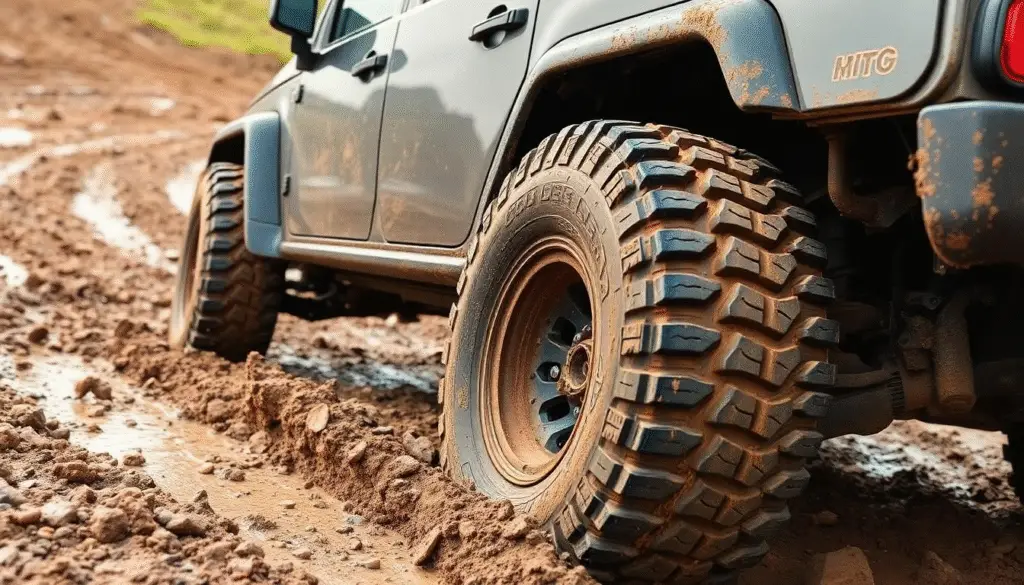
After testing dozens of mud tires over my years of off-roading, I’ve identified several brands that consistently deliver impressive longevity while maintaining performance. These options balance aggressive tread patterns with durable construction to maximize their lifespan beyond the typical 20,000-40,000 mile range.
BFGoodrich Mud-Terrain T/A KM3
BFGoodrich mud tires feature proprietary Krawl-TEK compound technology that enhances durability without sacrificing off-road grip. The T/A KM3 typically achieves 35,000-40,000 miles with proper maintenance. Their sidewall design includes “Mud-Phobic” bars that prevent mud buildup and reduce potential weak points that lead to premature failure.
Goodyear Wrangler DuraTrac
The Wrangler DuraTrac combines mud-terrain capability with all-terrain longevity. These tires incorporate Goodyear’s TractiveGroove Technology and a more densely packed tread pattern that resists chunking. Many users report 40,000+ miles from these hybrid tires, making them excellent options for those wanting mud performance without sacrificing longevity.
Falken Wildpeak M/T
Falken’s mud tires feature heat diffuser technology in the lower sidewall that protects the internal tire components from heat buildup—a common cause of premature tire failure. The three-ply sidewall construction and aggressive upper sidewall design provide exceptional puncture resistance. The Wildpeak M/T consistently achieves 30,000-35,000 miles even with regular off-road use.
Nitto Trail Grappler M/T
The Trail Grappler strikes an excellent balance between the more aggressive Mud Grappler and the longer-lasting Terra Grappler. Its reinforced shoulder grooves and 3-ply sidewall construction improve durability while maintaining off-road traction. These tires commonly last 40,000+ miles with proper rotation and maintenance, putting them at the upper end of mud tire longevity.
Cooper Discoverer STT Pro
Cooper’s STT Pro incorporates Armor-Tek3 construction that adds an extra ply to the sidewall, increasing puncture resistance and overall durability. The alternating tread pattern reduces irregular wear, helping these tires reach 35,000-40,000 miles. Their silica-infused tread compound improves wear characteristics particularly in hot weather conditions where other mud tires often struggle.
Toyo Open Country M/T
Toyo’s Open Country M/T features hook-shaped tread blocks and scalloped shoulder blocks that maintain traction even as the tire wears. The over-the-shoulder tread design provides extra grip points while protecting vulnerable sidewall areas. These premium mud tires consistently reach 40,000-45,000 miles with proper maintenance, making them one of the longest-lasting true mud tires available.
Factors That Influence Longevity in Premium Mud Tires
Premium mud tires that last longer typically share several key characteristics:
- Three-ply sidewall construction instead of the standard two-ply
- Higher silica content in the rubber compound for better heat dissipation
- Reinforced shoulder areas to prevent common failure points
- More robust internal belt packages using nylon or aramid materials
- Specialized tread designs that wear more evenly across the contact patch
These construction features often justify the higher price point of premium mud tires, as they can deliver an additional 10,000-15,000 miles of service life compared to budget alternatives.
Conclusion
Mud tires offer unmatched performance in challenging off-road conditions but typically last 20,000-40,000 miles—significantly less than standard tires. This shorter lifespan reflects their specialized design with aggressive tread patterns and softer rubber compounds.
Through my years of off-roading experience I’ve learned that balancing performance with longevity requires understanding the trade-offs. Premium brands like Toyo and BFGoodrich can extend your mileage to 45,000+ miles while budget options may only reach 25,000 miles.
The key to maximizing mud tire life lies in proper maintenance regular rotations and appropriate pressure adjustments for different terrains. By watching for wear indicators and performance changes you’ll know exactly when replacement is necessary.
For many enthusiasts the superior off-road capability justifies the more frequent replacements and higher costs—it’s simply part of the adventure.
Frequently Asked Questions
How long do mud tires typically last?
Mud tires typically last between 20,000 to 40,000 miles, with premium brands potentially reaching up to 50,000 miles with proper care. Actual lifespan varies significantly based on driving habits, maintenance practices, and terrain conditions. Mud tires wear faster than standard all-season tires due to their aggressive tread patterns and softer rubber compounds, especially when used frequently on paved roads.
What factors affect mud tire longevity?
Key factors include driving conditions (highway driving accelerates wear), terrain types (rocky terrain causes cuts), maintenance practices (proper pressure and rotation), and vehicle weight (heavier vehicles compress treads more). Temperature variations also impact durability—cold weather can cause stiffness and cracking, while hot conditions soften rubber and accelerate wear. Regular tire maintenance and appropriate usage for terrain conditions significantly extend tire life.
How do mud tires compare to all-terrain tires in terms of durability?
All-terrain tires typically last 40,000-60,000 miles, outlasting mud tires (20,000-40,000 miles). All-terrains feature harder rubber compounds and more densely packed tread blocks, offering better on-road comfort, reduced noise, and improved fuel efficiency. While mud tires excel in extreme off-road conditions, all-terrain tires provide better overall durability for drivers who primarily use paved roads with occasional off-road adventures.
When should I replace my mud tires?
Replace mud tires when they reach the legal minimum tread depth of 2/32 inch (visible tread wear indicators), or when you notice performance changes like reduced traction in mud, increased hydroplaning, unusual vibrations, or excessive road noise. The penny test (Lincoln’s head visible means replacement needed) and diminished off-road performance (difficulty handling off-camber situations or reduced climbing ability) are also reliable indicators.
How can I extend the life of my mud tires?
Rotate tires every 4,000-6,000 miles for even wear, check wheel alignment after off-roading, maintain proper tire inflation (adjust for different terrains), and store seasonal tires properly to prevent rubber degradation. For maximum longevity, many serious off-roaders use separate tire sets for daily driving and weekend adventures. Reducing highway speeds and avoiding aggressive driving techniques also significantly extend mud tire life.
Which mud tire brands are known for longevity?
The most durable mud tire brands include BFGoodrich Mud-Terrain T/A KM3, Goodyear Wrangler DuraTrac, Falken Wildpeak M/T, Nitto Trail Grappler M/T, Cooper Discoverer STT Pro, and Toyo Open Country M/T. Premium brands typically feature three-ply sidewall construction, higher silica content, and specialized tread designs that enhance durability. While more expensive, premium mud tires often provide better value through extended service life compared to budget alternatives.
